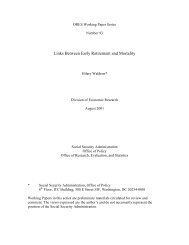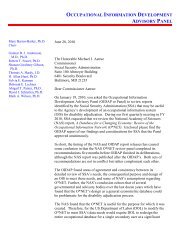Download entire publication - Social Security
Download entire publication - Social Security
Download entire publication - Social Security
You also want an ePaper? Increase the reach of your titles
YUMPU automatically turns print PDFs into web optimized ePapers that Google loves.
coverage varies significantly by race/ethnicity, education,and other characteristics, differences in thecomposition of cohorts may mitigate or exacerbate theimpact of the pension shift on retirement outcomes.ResultsWe begin by looking at the level and compositionof retirement income under the baseline and U.K.scenarios. An assessment is then made on how theaccelerated decline in DB coverage will affect differentdemographic groups. Next we examine numbersand characteristics of winners and losers from thechange in pension coverage. What might be drivingthe projected outcomes is then discussed. We end withreporting mean per capita family income at age 67in 2007 dollars. Because the mean statistic is notrepresentative when the data are skewed, we excludeindividuals with family wealth in the top 5 percent ofthe distribution.Projected Sources of Retirement IncomesUnder the Baseline and U.K. ScenariosAmong the first wave of boomers, 85 percent areexpected to have income from financial assets, and48 percent will have earnings, either their own or theirspouses’ (Table 2). Only 3 percent of individuals areprojected to receive SSI payments, but 85 percent willhave imputed rental income from homeownership and94 percent will receive <strong>Social</strong> <strong>Security</strong> benefits. Underthe baseline scenario, 50 percent of first-wave boomersare projected to have family DB pension benefitsand 76 percent are projected to have DC retirementaccounts. Pension coverage does not change under theU.K. scenario for first-wave boomers because no onewho had DB coverage before the freeze loses theircoverage (although, as we show below, their benefitsare reduced), and because first-wave boomers are nearor at retirement age and are less likely than youngerworkers to take-up DC pensions when newly offered.Compared with the first wave of boomers, the lastwave of boomers is equally likely to have incomefrom assets (86 percent versus 85 percent), but lesslikely to have earnings (42 percent versus 48 percent).Under the baseline, last-wave boomers are 6 percentagepoints less likely than first-wave boomers to haveDB pension benefits (44 percent versus 50 percent),but are equally likely to have DC retirement accounts(77 percent versus 76 percent). The U.K. scenarioaccelerates the shift from DB to DC pensions, reducingthe share of last-wave boomers with DB pensionsby an additional 2 percentage points and increasingthe share with DC retirement accounts by 2 percentagepoints, compared with the baseline. Freezingmore DB plans does not cause many boomers to loseDB coverage because all workers with existing DBplans retain them, even though they stop accruingbenefits, and some workers who are not vested gaincoverage. The only workers who lose coverage underthe U.K. scenario are those who started a new job thatprovides a DB pension subject to a hard freeze. TheU.K. scenario also increases the numbers with DCcoverage only slightly because many of the affectedworkers already had DC coverage from their prior orcurrent jobs.Table 2.Percent of individuals with family income at age 67, by scenario and income source (in percent)Scenario and income sourceFirst boomers(1946–1950)Second boomers(1951–1955)Third boomers(1956–1960)Last boomers(1961–1965)BaselineIncome from assets 85 86 86 86Earnings 48 44 42 42SSI payments 3 2 2 2Imputed rental income 85 85 84 83<strong>Social</strong> <strong>Security</strong> benefits 94 94 95 94DB pension benefits 50 48 46 44Retirement accounts 76 76 77 77Total income 100 100 100 100United KingdomDB pension benefits 50 48 46 42Retirement accounts 76 77 78 79Total income 100 100 100 100SOURCE: Authors' computations of MINT5 (see text for details).NOTE: Projections exclude individuals with family wealth in the top 5 percent of the distribution.8 <strong>Social</strong> <strong>Security</strong> Bulletin • Vol. 69 • No. 3 • 2009








